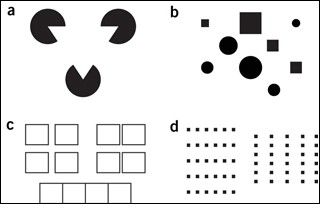
Creating figures for scientific papers is discussed in the course, including Gestalt principles for how we interpret visual data. (a) An illustration of subjective contour. (b) Similar objects are visually grouped. (c) Objects placed close to one another are seen as going together. (d) Relative proximity elicits vertical or horizontal correlations between objects. (Reprinted by permission from Macmillan Publishers Limited: Nature. Source: Wong, Bang. "Points of View: Gestalt Principles (Part 1)." Nature Methods 7, no. 11 (2010): 863.)
Instructor(s)
Prof. Mark Bathe
Prof. Jeff Gore
MIT Course Number
20.416J / 7.74J / 8.590J
As Taught In
Fall 2014
Level
Graduate
Course Description
Educator Features
Course Description
This course provides broad exposure to research in biophysics and physical biology, with emphasis on the critical evaluation of scientific literature. Weekly meetings include in-depth discussion of scientific literature led by various MIT faculty on active research topics. Each session also includes a brief discussion of non-research topics including effective presentation skills, writing papers and fellowship proposals, choosing scientific and technical research topics, time management, and scientific ethics.


